Analysis of Spatiotemporal Distribution Trends of Aerosol Optical Depth and Meteorological Influences in Gansu Province, Northwest China
Abstract
1. Introduction
2. Study Area, Data, and Methodology
2.1. Study Area
2.2. Data Sources and Preprocessing
2.3. Methodology
2.3.1. Mann–Kendall Trend Test
2.3.2. Theil–Sen Slope Estimator
2.3.3. Trend Classification Rules
- Significant decrease: p < 0.1 and β ≤ −0.005 (≤−0.5%/yr)Significant increase: p < 0.1 and β ≥ 0.005 (≥0.5%/yr)Essentially unchanged: p ≥ 0.1 or −0.005 < β < 0.005
2.3.4. Lindeman–Merenda–Gold (LMG) Method
- Between-group contribution: Calculate the relative contribution of the meteorological group and the emission group to the model’s explained variance (R2):where K is the number of permutations (K = 10,000).
- Within-group contribution: Allocate the relative importance of each factor within its group using the LMG method:
3. Results and Analysis
3.1. Analysis of Spatial Variation and Trends in AOD
3.2. Temporal Characteristics of AOD
3.3. Spatial Correlation Analysis Between AOD and Meteorological Factors
3.4. Relative Contributions of Local Emissions and Meteorological Factors to Seasonal AOD Variation
4. Discussion
5. Conclusions
- (1)
- Influenced by altitude, topography, and human activities, the spatial distribution of AOD in Gansu Province exhibits distinct regional differences. High AOD values are mainly concentrated in the Hexi Corridor and central regions, while low values are distributed in the Qilian Mountains and southern regions. The spatial extent of high AOD values is largest in spring, essentially recedes in summer and autumn, and begins to expand gradually in winter. Monthly mean distributions show that a high AOD center forms in southeastern Gansu in January, expands northward in February, covers almost the entire province by March, peaks in April, begins to shrink in May, and forms a relatively high-value area in central and eastern regions by December.
- (2)
- AOD changes in Gansu Province from 2009 to 2019 exhibited significant regional and temporal differences. Overall, AOD across the province was dominated by significant decreases (52.8%) or remained essentially unchanged (47.1%), with increasing areas accounting for only 0.1%, mainly distributed in the central Hexi Corridor, Hedong region, and eastern Gannan Plateau. By period, during 2009–2013, AOD was generally stable or significantly increasing (increasing areas accounted for 4.8%, concentrated in eastern Hedong and the Hexi Corridor), and attributed to rapid economic growth, sharp population density increase, and weak atmospheric environmental management. After the implementation of the “Air Pollution Prevention and Control Action Plan” in September 2013, air quality continuously improved from 2014 to 2019, with AOD significantly decreasing (99.8% stable or decreasing). Decreasing areas expanded persistently in the Hexi Corridor and eastern Hedong region. Seasonally, AOD remained stable or decreased in the vast majority of areas (>94%) in all seasons. However, the proportion of areas with significant decreases was highest in spring (52.6%), while increasing areas expanded somewhat in autumn (4.6%). The sub-period analyses showed that during 2009–2013, increasing areas expanded significantly in spring and autumn (4.3% and 5.7%, respectively), decreasing areas expanded in summer (9.1%), and stable conditions dominated in winter (96.5%). In contrast, during 2014–2019, increasing areas plummeted to less than 1.0% in all seasons, with stable or decreasing trends overwhelmingly dominant (95.4–99.5%), indicating that policy intervention effectively promoted stable regional air quality improvement.
- (3)
- From 2009 to 2019, AOD in Gansu Province ranged between 0.119 and 0.185, showing an overall slow decreasing trend. Spring AOD was generally higher than in other seasons, but its decreasing trend was also the most pronounced. Monthly mean AOD fluctuated between 0.091 and 0.293, exhibiting a “unimodal” variation pattern.
- (4)
- Spatially, the Hexi Corridor is characterized by strong negative RH2 correlations year-round, strong negative WS correlations in winter and spring, significant positive T2 correlation in spring, and negative T2 correlation in the north in summer. The Hedong region is marked by a prominent positive PBLH correlation in summer, strong positive T2 correlations in spring and summer, and consistently negative RH2 correlations. The Gannan Plateau exhibits positive WS correlation in spring, weak positive RH2 correlations in spring and autumn, positive T2 correlation in spring, and negative T2 correlation in autumn. Seasonally, PBLH showed weak negative correlations over most areas in spring (local positive correlations in Qilian Mountains and Gannan Plateau), shifted to significant positive correlation in Hedong but negative in Hexi/Gannan in summer, and was mostly negative in autumn and winter. RH2 was predominantly negatively correlated year-round, but showed weak positive correlations in the Gannan Plateau during spring and autumn. T2 showed mainly positive correlations in spring and summer (strong positive in central Hexi spring and strong positive in Hedong summer), shifted to mostly negative in autumn (except weak positive in Qilian Mountains), and showed a weak positive correlation in winter. WS showed negative correlations dominating year-round, but a positive correlation in the Gannan Plateau spring, weak positive in summer, strong negative in the Hexi winter, and weak correlations elsewhere. Overall, the association between AOD and meteorological factors exhibits distinct gradient differentiation across the arid zone (Hexi), industrial zone (Hedong), and alpine zone (Gannan). Notably, PBLH positive correlation occurs only in summer Hedong, T2 negative correlation concentrates in autumn, and WS positive correlation is limited to the warm season in Gannan, highlighting the decisive regulatory role of regional underlying surface properties on meteorological effects.
- (5)
- In 80% of seasonal scenarios (13 out of 16), emission factors (PM2.5, , , , OM, and BC) contributed over 50% to AOD. Emissions dominated year-round in the Hexi Corridor (71% to 95%) and Hedong region (68% to 80%), and in spring (69%) and summer (72%) on the Gannan Plateau. Regarding component contributions, BC contributed over 30% in 11 seasons (e.g., 52.5% in Hedong summer and 46.2% in Gannan summer); and synergistically contributed over 57% in Hexi summer and autumn; and OM played a significant role in Gannan summer (20.3%) and province-wide spring (19.0%). Meteorological factors dominated only in specific scenarios: Gannan Plateau winter (82%) and autumn (61%), dominated by T2; and province-wide summer (67%), dominated by RH2 and WS.
Author Contributions
Funding
Data Availability Statement
Acknowledgments
Conflicts of Interest
References
- Li, C.; Mao, J.; Lau, A.K.H. Remote Sensing Aerosol with MODIS and the Application of MODIS Aerosol Products. Acta Sci. Nat. Univ. Pekin. 2003, 39, 108–117. [Google Scholar] [CrossRef]
- Ramanathan, V.; Li, F.; Ramana, M.V.; Praveen, P.S.; Kim, D.; Corrigan, C.E.; Nguyen, H.; Stone, E.A.; Schauer, J.J.; Carmichael, G.R.; et al. Atmospheric brown clouds: Hemispherical and regional variations in long-range transport, absorption, and radiative forcing. J. Gephysical Res. Atmos. 2007, 112, D22S21. [Google Scholar] [CrossRef]
- Li, Z.Q.; Niu, F.; Fan, J.W.; Liu, Y.G.; Rosenfeld, D.; Ding, Y.N. Long-term impacts of aerosols on the vertical development of clouds and precipitation. Nat. Geosci. 2019, 12, 888–894. [Google Scholar] [CrossRef]
- Liu, H.; Gao, X.M.; Xie, Z.Y.; Li, T.T.; Zhang, W.J. Spatio-temporal characteristics of aerosol optical depth over Beijing-Tianjin-Hebei-Shanxi-Shandong region during 2000–2013. Acta Sci. Circumstantiae 2015, 35, 1506–1511. [Google Scholar] [CrossRef]
- Zhang, S.; Wu, J.; Fan, W.X.; Yang, Q.D.; Zhao, D.M. Review of aerosol optical depth retrieval using visibility data. Earth-Sci. Rev. 2020, 200, 102986. [Google Scholar] [CrossRef]
- Stefanie, H.I.; Radovici, A.; Mereuta, A.; Arghius, V.; Camarasan, H.; Costin, D.; Botezan, C.; Ginsca, C.; Ajtai, N. Variation of Aerosol Optical Properties over Cluj-Napoca, Romania, Based on 10 Years of AERONET Data and MODIS MAIAC AOD Product. Remote Sens. 2023, 15, 3072. [Google Scholar] [CrossRef]
- Gui, K.; Che, H.Z.; Chen, Q.; Zeng, Z.; Zheng, Y.; Long, Q.; Sun, T.; Liu, X.; Wang, Y.; Liao, T. Water vapor variation and the effect of aerosols in China. Atmos. Environ. 2017, 165, 322–335. [Google Scholar] [CrossRef]
- Luo, Y.X.; Zheng, X.B.; Zhao, T.L.; Chen, J. Climatology of aerosol optical depth over China from recent 10 years of MODIS remote sensing data. Ecol. Environ. Sci. 2012, 21, 876–883. [Google Scholar] [CrossRef]
- Tie, X.X.; Wu, D.; Brasseur, G. Lung cancer mortality and exposure to atmospheric aerosol particles in Guangzhou, China. Atmos. Environ. 2009, 43, 2375–2377. [Google Scholar] [CrossRef]
- Schäfer, K.; Thomas, W.; Peters, A.; Ries, L.; Obleitner, F.; Schnelle-Kreis, J.; Birmili, W.; Diemer, J.; Fricke, W.; Junkermann, W.; et al. Influences of the 2010 Eyjafjallajökull volcanic plume on air quality in the northern Alpine region. Atmos. Chem. Phys. 2011, 11, 8555–8575. [Google Scholar] [CrossRef]
- Chen, X.F.; de Leeuw, G.; Arola, A.; Liu, S.M.; Li, Z.Q.; Zhang, K.N. Joint retrieval of the aerosol fine mode fraction and optical depth using MODIS spectral reflectance over northern and eastern China: Artificial neural network method. Remote Sens. Environ. 2020, 249, 112006. [Google Scholar] [CrossRef]
- Zhang, Y.; Xiao, Z.Y. Temporal-Spatial Variations Characteristics of Aerosol Optical Thickness using Satellite Remote Sensing over Yunnan Province, China. Environ. Monit. China 2016, 32, 127–133. [Google Scholar] [CrossRef]
- Wang, C.Y.; He, M.Q.; Chen, J.H.; Liu, Z.H. Temporal and Spatial Variation Characteristics of MODIS Aerosol Optical Depth in Sichuan Basin from 2006 to 2017. Res. Environ. Sci. 2020, 33, 54–62. [Google Scholar] [CrossRef]
- Zhang, M.; Wang, Y.; Ma, Y.Y.; Wang, L.C.; Gong, W.; Liu, B.M. Spatial distribution and temporal variation of aerosol optical depth and radiative effect in South China and its adjacent area. Atmos. Environ. 2018, 188, 120–128. [Google Scholar] [CrossRef]
- Wang, W.B.; Zhu, D.Y.; Jing, C.S.; Guo, X.G.; Chen, L. Spatial distribution and temporal variation of aerosol optical depth in the Western Pacific Ocean. Dyn. Atmos. Ocean. 2022, 99, 101303. [Google Scholar] [CrossRef]
- Seema, R.; Rajesh, K. Spatial distribution of aerosol optical depth over India during COVID-19 lockdown phase-1. Spat. Inf. Res. 2022, 30, 417–426. [Google Scholar] [CrossRef]
- Che, H.Z.; Xia, X.G.; Zhao, H.J.; Li, L.; Gui, K.; Zheng, Y.; Song, J.J.; Qi, B.; Zhu, J.; Miao, Y.C.; et al. Aerosol optical and radiative properties and their environmental effects in China: A review. Earth-Sci. Rev. 2024, 248, 104634. [Google Scholar] [CrossRef]
- Zhang, X.; Li, L.; Che, H.; Dubovik, O.; Derimian, Y.; Holben, B.; Gupta, P.; Eck, T.F.; Lind, E.S.; Toledano, C. Aerosol Components Derived from Global AERONET Measurements by GRASP: A New Value-Added Aerosol Component Global Dataset and Its Application. Bull. Am. Meteorol. Soc. 2024, 105, E1822–E1848. [Google Scholar] [CrossRef]
- Mayila, R.; Ding, J.L.; Zhang, Z.; Zhang, Z.H.; Chen, X.Y.; Liu, S.Y. Spatiotemporal distribution characteristics and potential sources of aerosol optical depth in Urumqi. Acta Sci. Circumstantiae 2020, 40, 1611–1620. [Google Scholar]
- Huang, F.F.; Ma, W.Q.; Wang, S.C.; Feng, C.; Kong, X.Y.; Liu, H. Analysis and Validation of the Aerosol Optical Depth of MODIS Products in Gansu Province, Northwest China. Remote Sens. 2023, 15, 2972. [Google Scholar] [CrossRef]
- Li, Y.Y.; Zhang, A.P.; Li, H.Y.; Wang, F.; Chen, Y.; Zeng, T. Relationship between Boundary Layer Height and Wind-sand Intensities over Hexi Corridor, China. J. Desert Res. 2019, 39, 11–20. [Google Scholar] [CrossRef]
- Ren, G.P.; Wei, Y.P.; Ke, W.; Qiao, G.; Wan, Z.X.; Liang, X.G. Characteristics of Atmospheric-boundary-layer Height and Its Relationship with Sand-dust Weather in Jiuquan of Gansu Province. J. Arid. Meteorol. 2020, 38, 979–986. [Google Scholar] [CrossRef]
- Huang, Y.; Chen, B.; Dong, L.; Zhang, Z.J. Analysis of a Dust Weather Process over East Asia in MAY 2019 Based on Satellite and Ground-Based Lidar. Chin. J. Atmos. Sci. 2021, 45, 524–538. [Google Scholar] [CrossRef]
- Li, Y.Y.; Zhang, C.Y.; Zhang, A.P.; Yang, J.P.; Chen, Y.; Nie, X. Vertical structure characteristics of atmospheric boundary layer in spring sandstorm over Hexi Corridor. Meteormon 2022, 48, 1171–1185. [Google Scholar] [CrossRef]
- Zhang, J.; Guo, N.; Di, X.H. Analysis on Precipitation in Winter and Relation with Sand Days in Northwest Region. J. Desert Res. 2004, 5, 87–90. [Google Scholar]
- Ding, K.; Liu, J.P. Spatial distribution dynamic changes of sand storm in northern China in recent 50 years. J. Arid. Land Resour. Environ. 2011, 25, 116–120. [Google Scholar] [CrossRef]
- Zhang, X.Y. Characteristics of the chemical components of aerosol particles in the various regions over China. Acta Meteoroligica Sin. 2014, 72, 1108–1117. [Google Scholar] [CrossRef]
- Li, M.Q. Formation Potential and Pollution Characteristics of Secondary Organic Aerosol in Lanzhou, China. Master’s Thesis, Lanzhou University, Lanzhou, China, 2021. [Google Scholar] [CrossRef]
- Li, J.C.; Pang, G.J.; Wang, X.J.; Liu, F.; Zhang, Y.T. Spatiotemporal Dynamics of Land Surface Albedo and Its Influencing Factors in the Qilian Mountains, Northeastern Tibetan Plateau. Remote Sens. 2022, 14, 1922. [Google Scholar] [CrossRef]
- Cheng, Z.G.; Pan, Y.B.; Li, J.; Jia, X.C.; Zhang, X.Y.; Ma, P.K.; Wang, Q.Q.; Dou, J.X.; Zhang, J.J.; Quan, J.N. Assessing the Influence of Aerosol on Radiation and Its Roles in Planetary Boundary Layer Development. J. Meteorol. Res. 2021, 35, 384–392. [Google Scholar] [CrossRef]
- Sha, B.N.; Yang, Y.H.; Huang, F.J.; Ye, M. Spatial and temporal distribution characteristics of the temperature inversion in Northwest China. Arid. Zone Res. 2025, 42, 397–408. [Google Scholar] [CrossRef]
- Chen, S.; Huang, J.; Kang, L.; Wang, H.; Ma, X.; He, Y.; Yuan, T.; Yang, B.; Huang, Z.; Zhang, G. Emission, transport, and radiative effects of mineral dust from the Taklimakan and Gobi deserts: Comparison of measurements and model results. Atmos. Chem. Phys. 2017, 17, 1–43. [Google Scholar] [CrossRef]
- Ning, Q.; He, M.; Ji, Y.Y.; Yin, H.; Li, J.D.; Shang, F.Y.; Zhang, K. Characteristics and Formation of Complex Air Pollution and Sources of VOCs in the Yellow River Delta Region. Res. Environ. Sci. 2024, 37, 439–454. [Google Scholar] [CrossRef]
- Chen, B.; Wu, C.; Liu, X.; Chen, L.; Wu, J.; Yang, H.; Luo, T. Seasonal climatic effects and feedbacks of anthropogenic heat release due to global energy consumption with CAM5. Clim. Dyn. 2019, 52, 6377–6390. [Google Scholar] [CrossRef]
- Zhang, F. Factors Influencing the Spatio–Temporal Variability of Aerosol Optical Depth over the Arid Region of Northwest China. Atmos. 2024, 15, 54. [Google Scholar] [CrossRef]
- Lv, X.H.; Tang, Z.Y.; Lv, W.W.; Tang, Y.Q.; Xie, X.H.; Tan, D.Q. Climate Characteristics Analysis and Forecast of Fog and Haze over Shaoyang in the Past 70 Years. Clim. Change Res. Lett. 2018, 7, 102–109. [Google Scholar] [CrossRef]
- Sayer, A.M.; Smirnov, A.; Hsu, N.C.; Holben, B.N. A pure marine aerosol model, for use in remote sensing applications. J. Geophys. Res. Atmos. 2012, 117, D05213. [Google Scholar] [CrossRef]
- Guo, C.Y.; Wang, Y.; Liu, H.; Liu, Y.; Wang, S.T.; Li, B. Spatial and temporal distribution characteristics and transport path analysis of regional particulate matter over Gansu Province. China Environ. Sci. 2021, 41, 3990–4000. [Google Scholar]
- Cui, H.X.; Cheng, T.T.; Yu, X.N.; Chen, J.M.; Xu, Y.F.; Fang, W. Laboratory simulation of SO2 heterogeneous reactions on hematite surface under different SO2 concentrations. J. Environ. Sci. 2009, 21, 1103–1107. [Google Scholar] [CrossRef]
- Tiwari, P.; Cohen, J.B.; Wang, X.Y.; Wang, S.; Qin, K. Radiative Forcing Bias Calculation Based on COSMO (Core—Shell MIE model Optimization) and AERONET data. NPJ Clim. Atmos. Sci. 2023, 6, 193. [Google Scholar] [CrossRef]
- Wu, C.; Zhang, S.; Wang, G.H.; Lv, S.J.; Li, D.P.; Liu, L.; Li, J.J.; Liu, S.J.; Du, W.; Meng, J.J. Efficient Heterogeneous Formation of Ammonium Nitrate on the Saline Mineral Particle Surface in the Atmosphere of East Asia during Dust Storm Periods. Environ. Sci. Technol. 2020, 54, 15622–15630. [Google Scholar] [CrossRef]
- Zhang, Y.L.; Zuo, H.C.; Gao, X.Q.; Fan, G.Z.; Lv, S.H.; Hua, W.; Dong, L.X. Evolution Characteristics of the Flows Around the Tibetan Plateau and the Relationship with the Climate in China in Winter. Front. Earth Sci. 2022, 10, 978995. [Google Scholar] [CrossRef]
- Yin, Z.L.; Feng, Q.; Zhu, R.; Wang, L.G.; Chen, Z.X.; Fang, C.S.; Lu, R. Analysis and prediction of the impact of land use/cover change on ecosystem services value in Gansu province, China. Ecol. Indic. 2023, 154, 110868. [Google Scholar] [CrossRef]
- Anquetin, S.; Guilbaud, C.; Chollet, J.P. Thermal valley inversion impact on the dispersion of a passive pollutant in a complex mountainous area. Atmos. Environ. 1999, 33, 3953–3959. [Google Scholar] [CrossRef]
- Liu, Z.; Zhang, H.; Zhang, Y.J.; Zhu, T.T. How does industrial policy affect the eco-efficiency of industrial sector? Evidence from China. Applied Energy 2020, 272, 115206. [Google Scholar] [CrossRef]
- Yi, W.Y.; Liu, G.P.; Wang, M.; Wang, J.; Chen, D.L.; Shen, J.L. Increased nitrogen deposition and airborne particulate matter pollution in the vicinity of intensive animal farms caused by ammonia emissions. Agric. Ecosyst. Environ. 2025, 387, 109634. [Google Scholar] [CrossRef]
- Chen, Y.; Sun, J.Z.; Zhang, W.; Meng, X.W.; Wang, J.; Sun, J.Z. Research on the correlation between MODIS aerosol optical depth and air pollution index over Lanzhou area. J. Lanzhou Univ. 2013, 49, 765–772. [Google Scholar] [CrossRef]
- Zhao, S.W.; Gao, X.Q. Study of aerosol optical depth and angstrom exponent in the northwest of China based on MODIS product. J. Atmos. Environ. Opt. 2017, 12, 321–331. [Google Scholar] [CrossRef]
- Zhang, X.H.; Zhang, W.; Chen, Y.; Feng, J.J.; Bi, J.R.; Shi, J.S.; Zhang, B.D.; Huang, J.P. Retrieval of aerosol optical depth with a custom aerosol model over Lanzhou and its surroundings. Plateau Meteorol. 2013, 32, 402–410. [Google Scholar] [CrossRef]
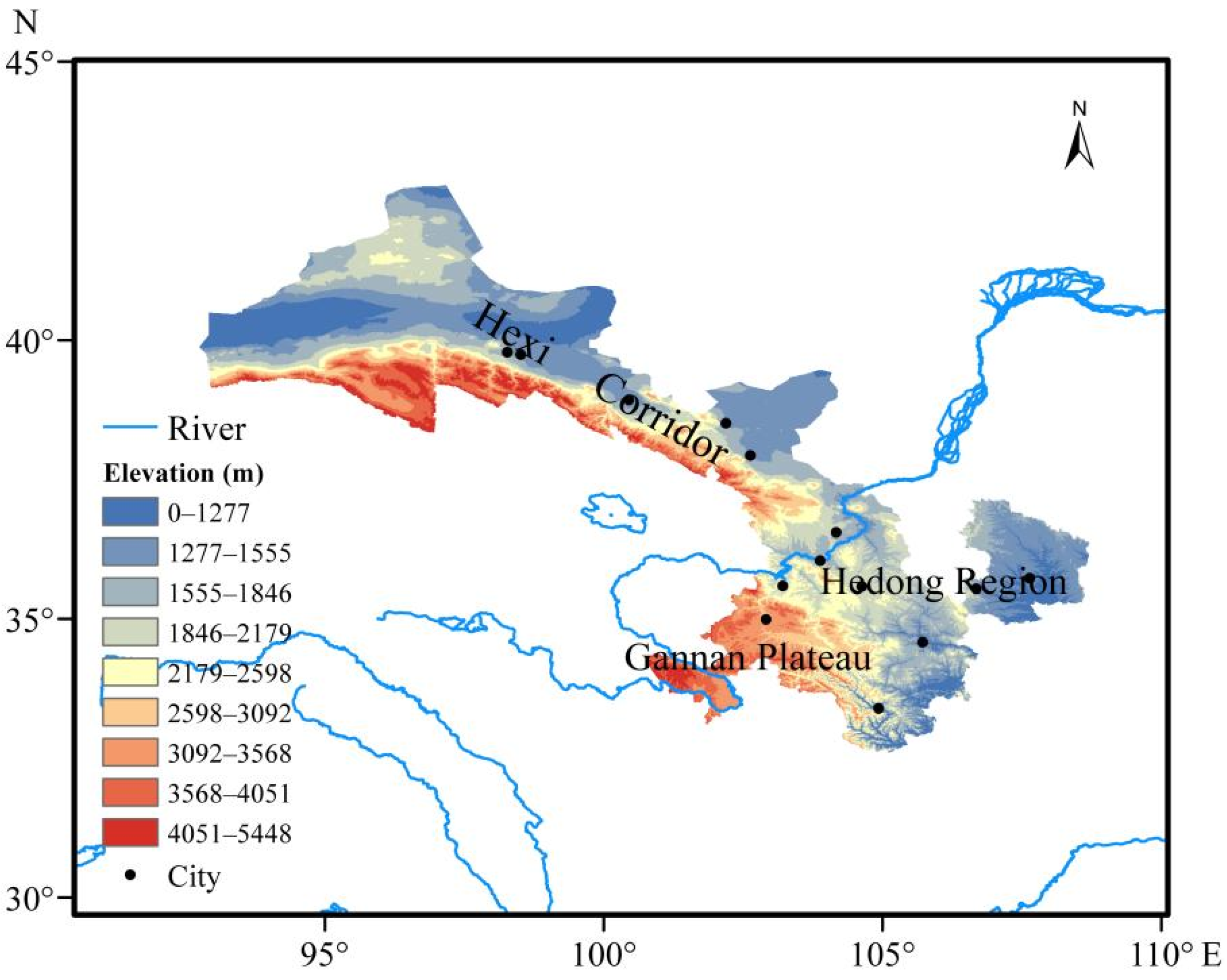
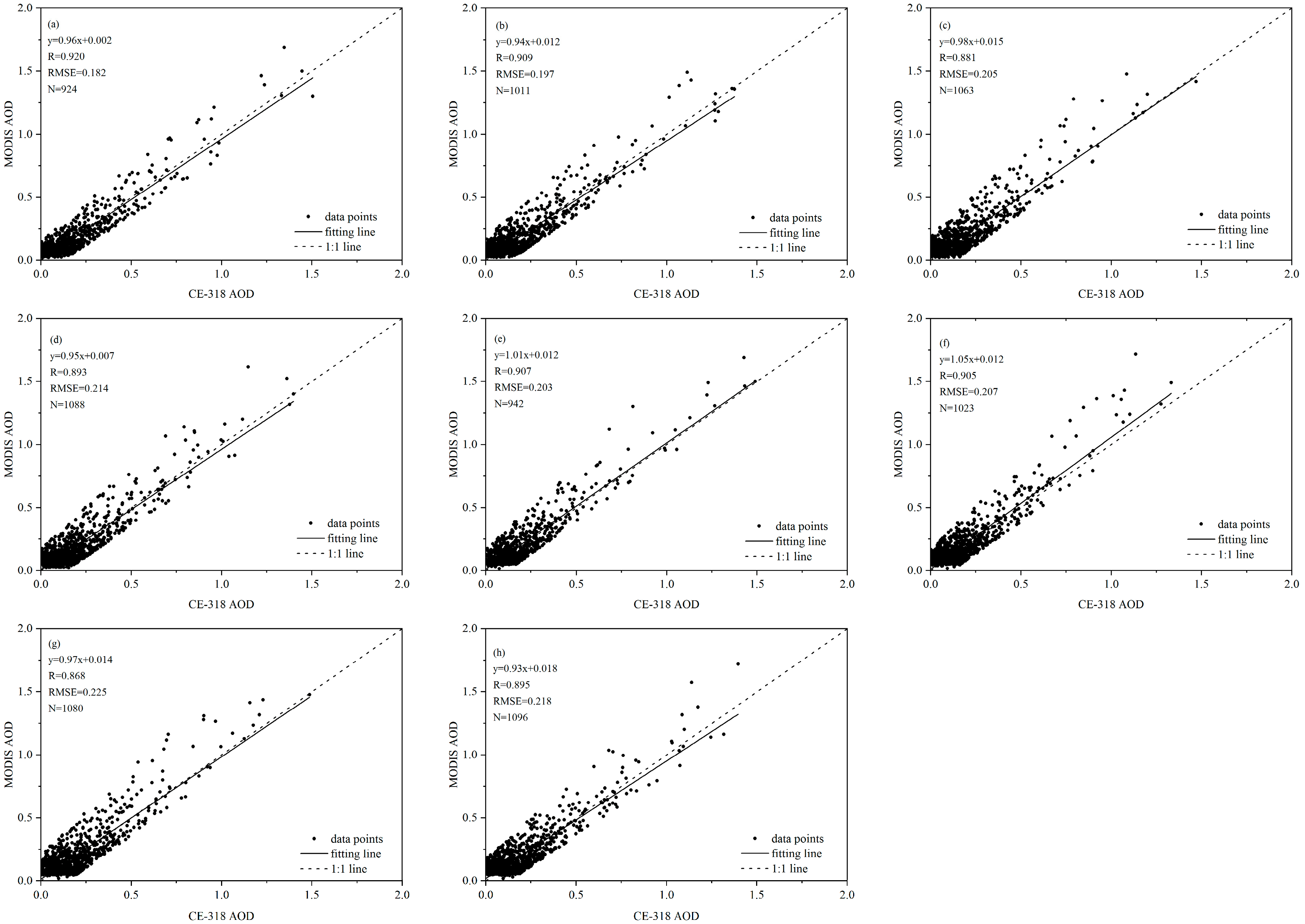
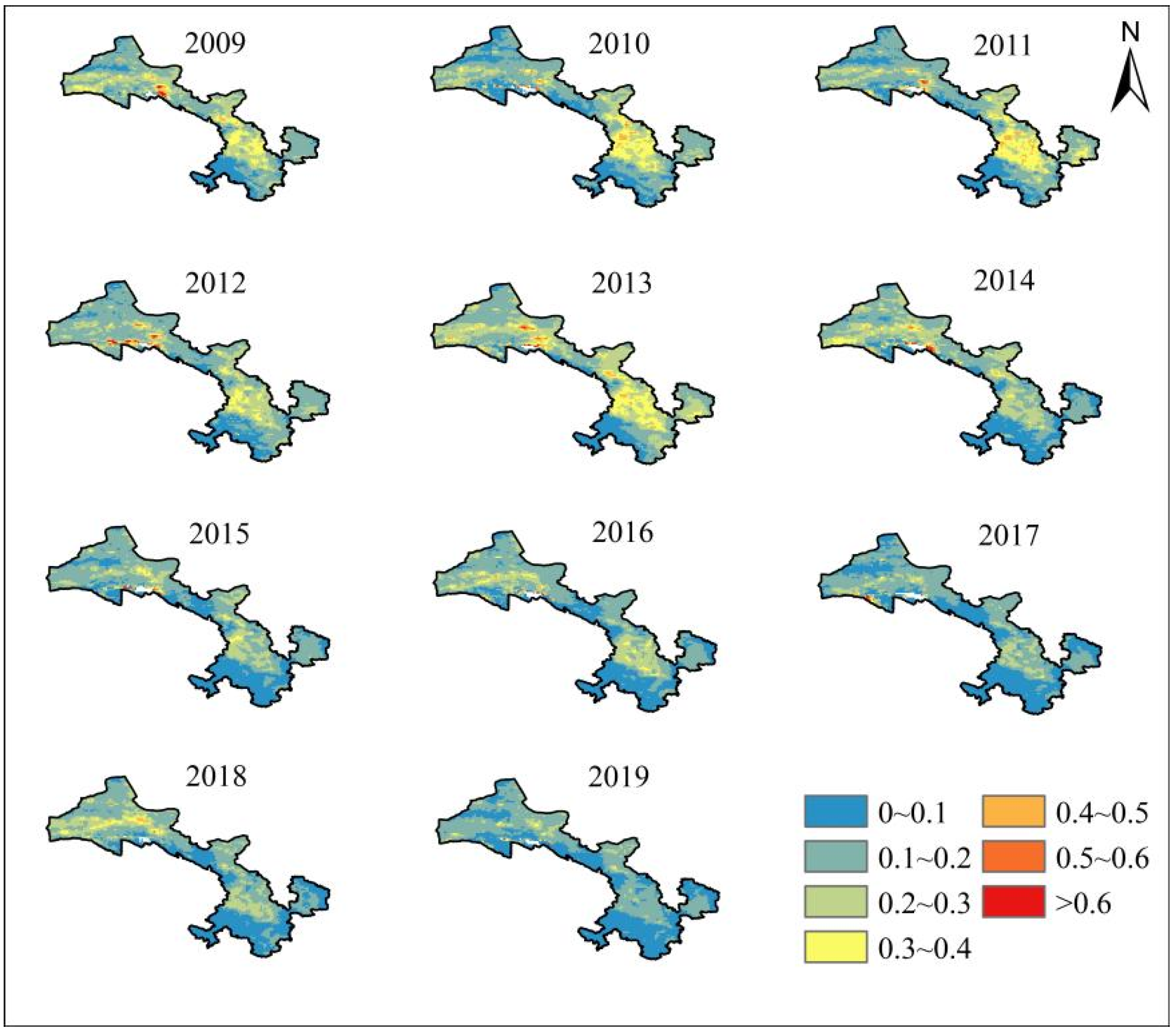
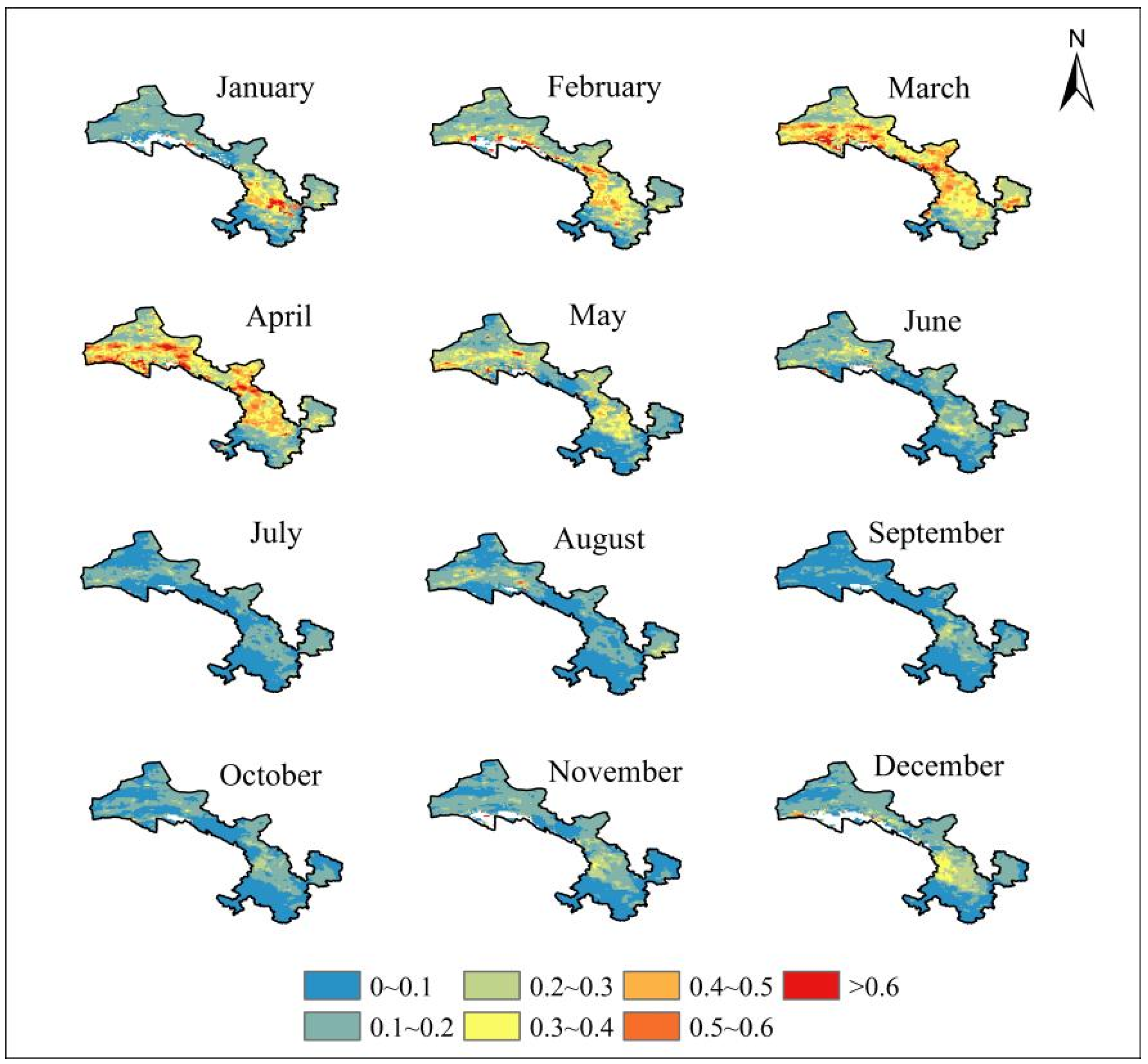
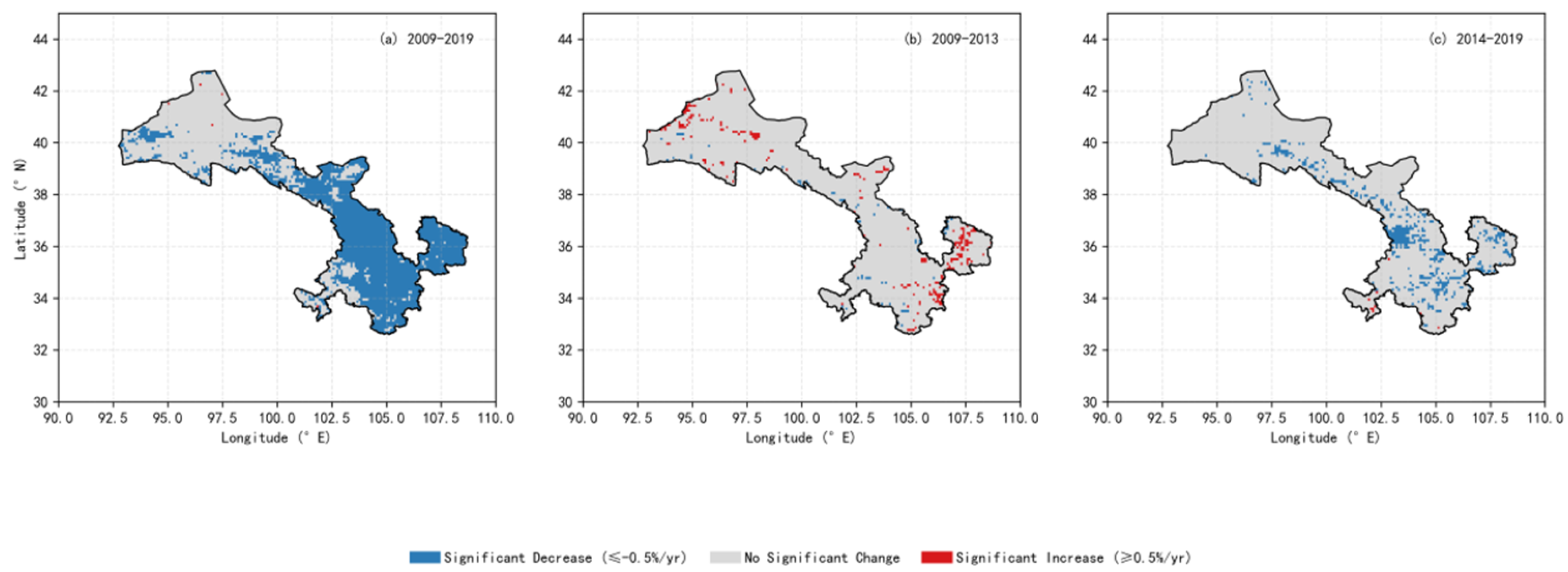
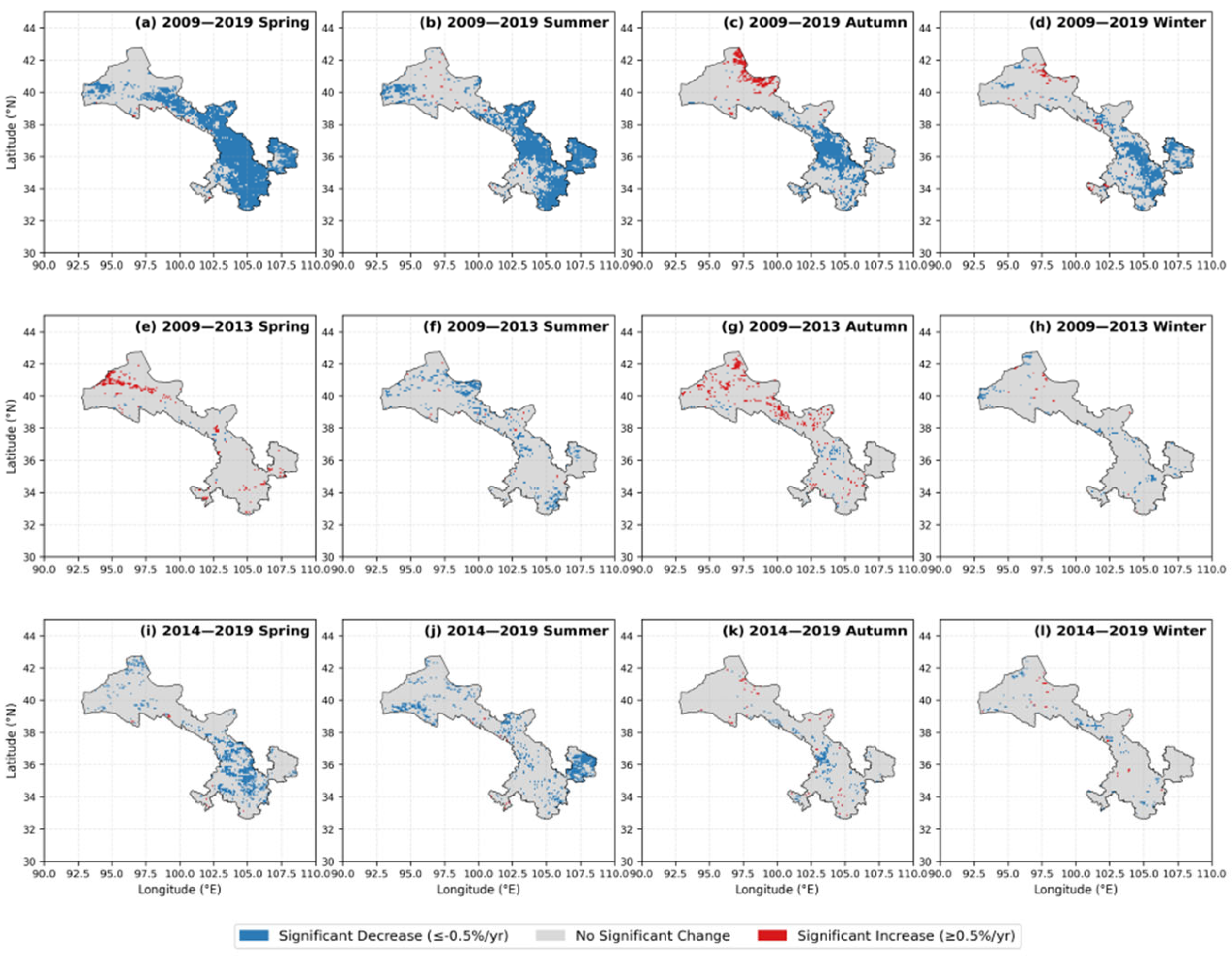

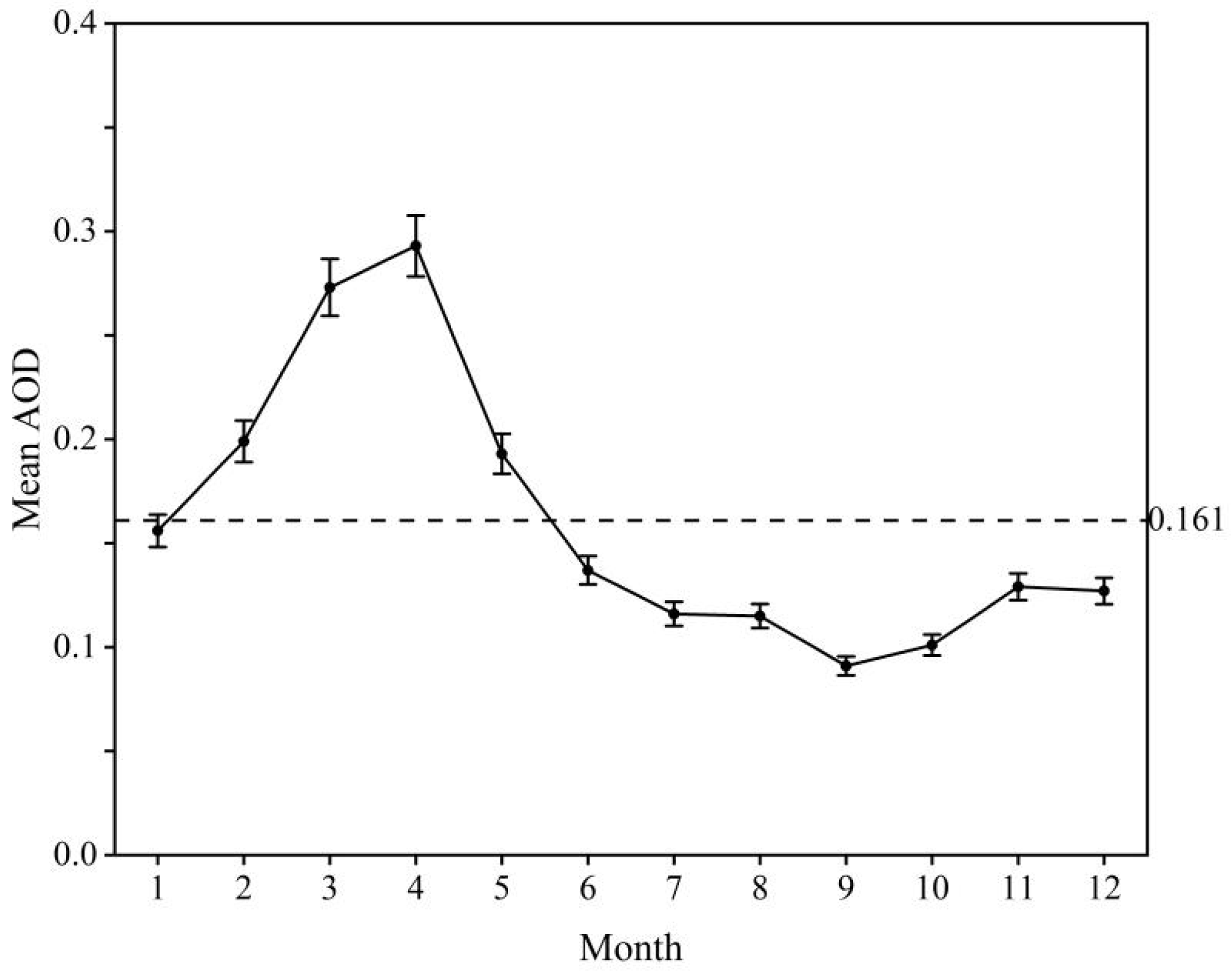
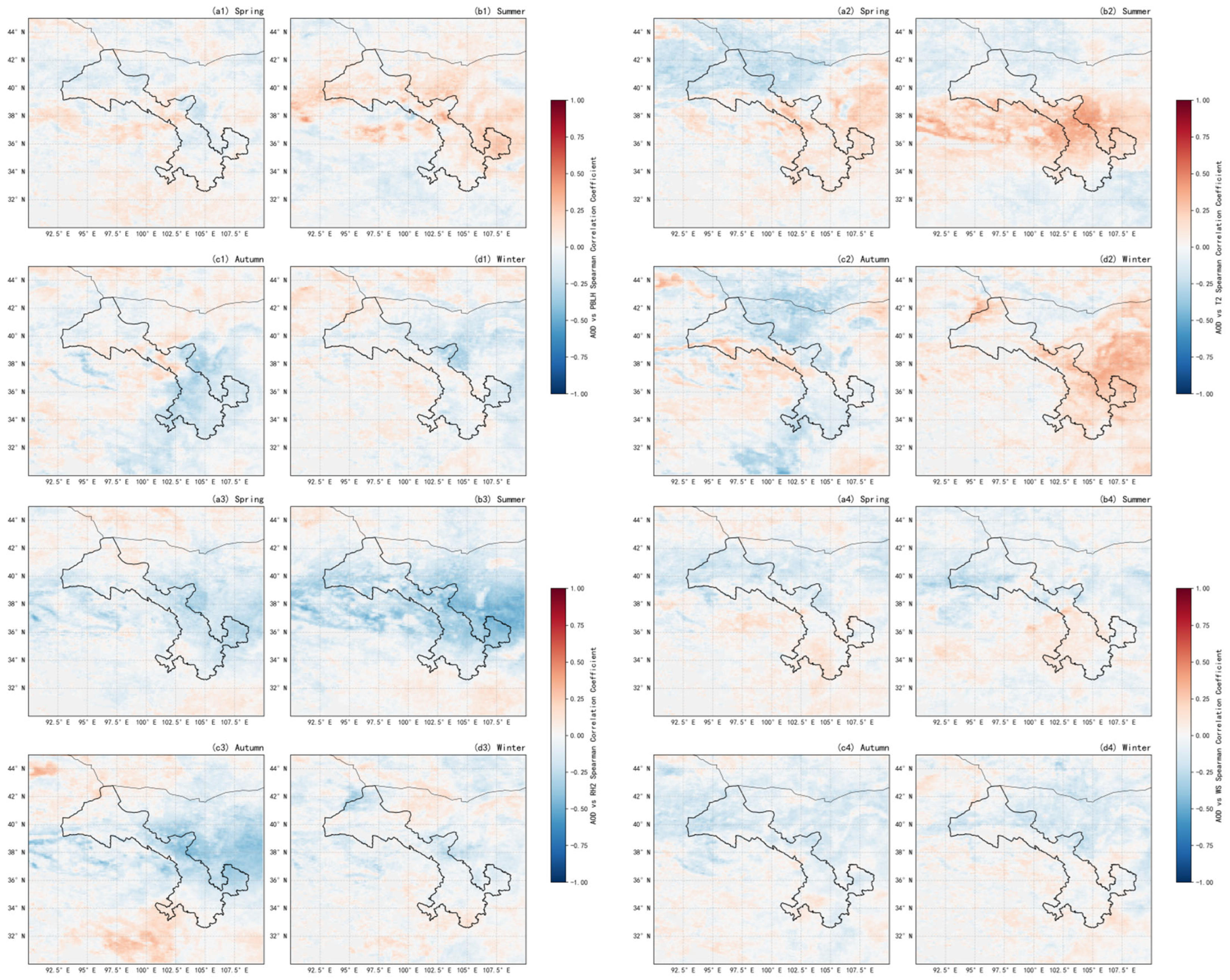
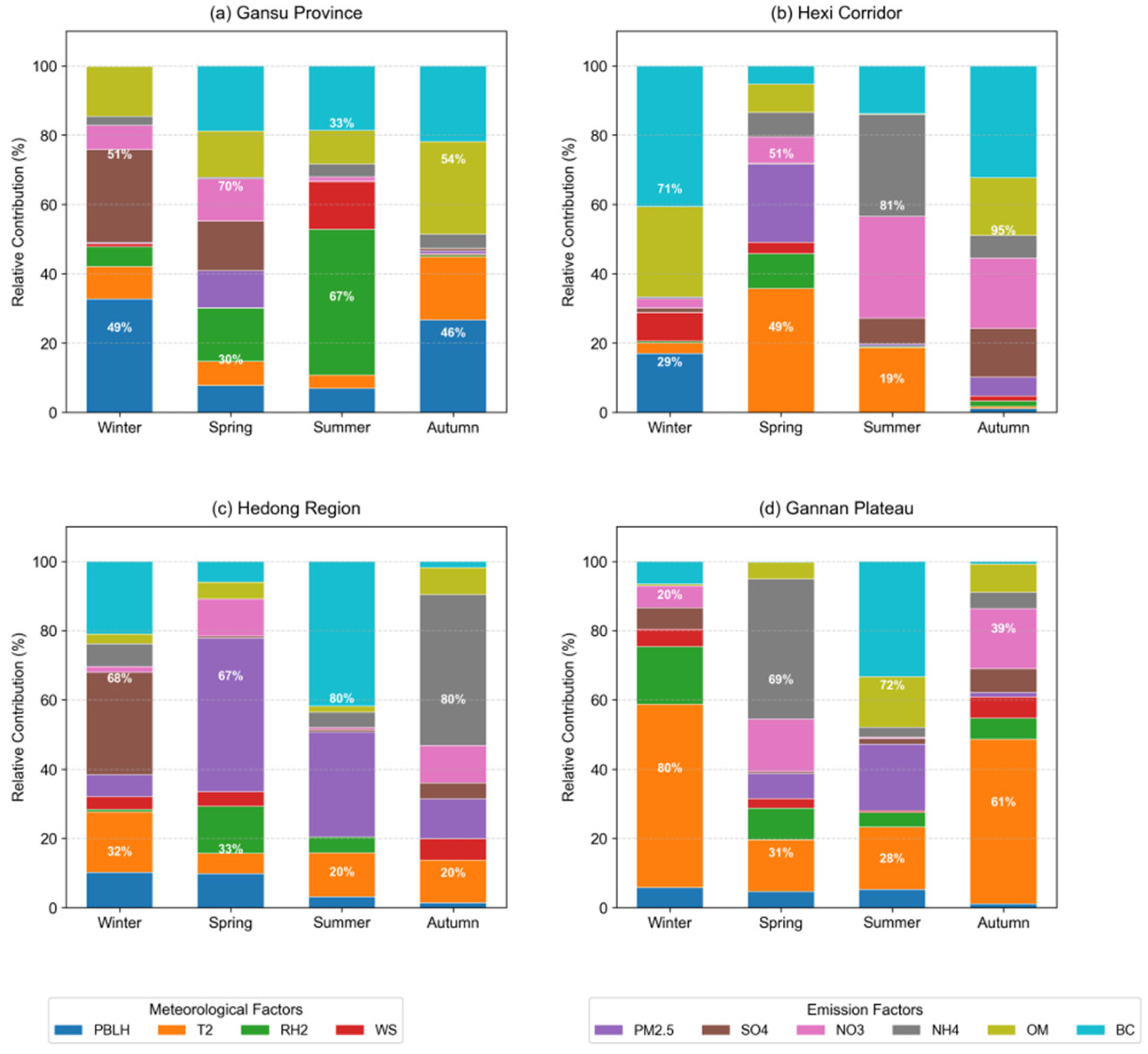
| Zone | Time Period | Year | Spring | Summer | Autumn | Winter |
|---|---|---|---|---|---|---|
| Significant Decrease | 2009–2019 | 52.8% | 52.6% | 41.8% | 19.5% | 20.2% |
| 2009–2013 | 1.5% | 0.7% | 9.1% | 1.7% | 3.1% | |
| 2014–2019 | 10.1% | 13.0% | 13.1% | 3.6% | 2.5% | |
| No Significant Change | 2009–2019 | 47.1% | 47.1% | 57.7% | 75.9% | 77.9% |
| 2009–2013 | 93.7% | 95.0% | 90.4% | 92.6% | 96.5% | |
| 2014–2019 | 89.7% | 86.8% | 86.7% | 95.4% | 97.0% | |
| Significant Increase | 2009–2019 | 0.1% | 0.3% | 0.5% | 4.6% | 1.8% |
| 2009–2013 | 4.8% | 4.3% | 0.5% | 5.7% | 0.4% | |
| 2014–2019 | 0.2% | 0.2% | 0.2% | 1.0% | 0.5% |
Disclaimer/Publisher’s Note: The statements, opinions and data contained in all publications are solely those of the individual author(s) and contributor(s) and not of MDPI and/or the editor(s). MDPI and/or the editor(s) disclaim responsibility for any injury to people or property resulting from any ideas, methods, instructions or products referred to in the content. |
© 2025 by the authors. Licensee MDPI, Basel, Switzerland. This article is an open access article distributed under the terms and conditions of the Creative Commons Attribution (CC BY) license (https://creativecommons.org/licenses/by/4.0/).
Share and Cite
Huang, F.; Gong, C.; Ma, W.; Liu, H.; Zhong, B.; Jing, C.; Fu, J.; Zhang, C.; Zhang, X. Analysis of Spatiotemporal Distribution Trends of Aerosol Optical Depth and Meteorological Influences in Gansu Province, Northwest China. Remote Sens. 2025, 17, 2874. https://doi.org/10.3390/rs17162874
Huang F, Gong C, Ma W, Liu H, Zhong B, Jing C, Fu J, Zhang C, Zhang X. Analysis of Spatiotemporal Distribution Trends of Aerosol Optical Depth and Meteorological Influences in Gansu Province, Northwest China. Remote Sensing. 2025; 17(16):2874. https://doi.org/10.3390/rs17162874
Chicago/Turabian StyleHuang, Fangfang, Chongshui Gong, Weiqiang Ma, Hao Liu, Binbin Zhong, Cuiwen Jing, Jie Fu, Chunyan Zhang, and Xinghua Zhang. 2025. "Analysis of Spatiotemporal Distribution Trends of Aerosol Optical Depth and Meteorological Influences in Gansu Province, Northwest China" Remote Sensing 17, no. 16: 2874. https://doi.org/10.3390/rs17162874
APA StyleHuang, F., Gong, C., Ma, W., Liu, H., Zhong, B., Jing, C., Fu, J., Zhang, C., & Zhang, X. (2025). Analysis of Spatiotemporal Distribution Trends of Aerosol Optical Depth and Meteorological Influences in Gansu Province, Northwest China. Remote Sensing, 17(16), 2874. https://doi.org/10.3390/rs17162874









